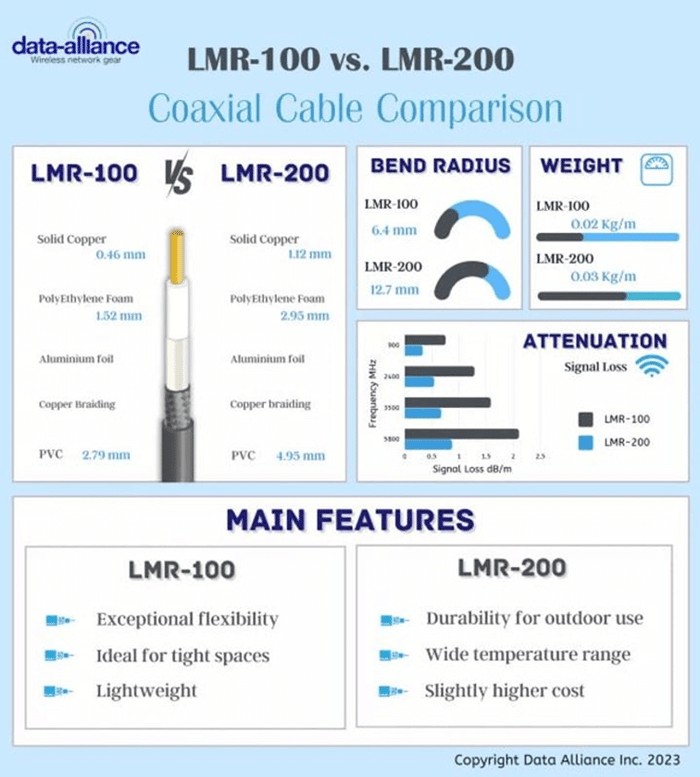Antennas, Antenna Cables, Wireless Products: Technical Articles
LMR-200 Cable Specifications Compared to LMR-100
LMR-200 Coax Cable:
LMR-200 "Low loss cable" differs from RG58 and other coax standards by double shielding and less attenuation (signal loss in the cable) than the standard cables (e.g. RG58). LMR-200 is equivalent or better quality compared to LMR-100 (generally better because LMR-200 is double-shielded).
- Rated for outdoor use and are also suitable for indoor use, very flexible/easily bendable coax.
The double-shielding is a major factor in the higher quality of this cable, which translates into lower loss/better performance. Suitable for applications, as well as any other frequency.
Application:
- Antenna cables for frequency bands between 0 and 18GHz: IoT and Wireless / Wi-Fi antenna networks: 802.11ac, 802.11n, AC, G, A, B. 900MHz, 2.4GHz & 5GHz.
- Temperature range -40°C to +85°C
- Data Alliance also uses LMR-100, CLF-100, and LMR-400 (all double-shielded) in our antenna cable products.LMR 200 LOW LOSS® COMPARED TO STANDARD "RG" COAXIAL CABLE:
50 Ω COAXIAL CABLE MATERIAL DIAMETER INNER CONDUCTOR Copper solid 1.12 mm DIELECTRIC PE foamed 2.95 mm SHIELDING Copper braid tinned / Aluminum Foil 3.66 mm CABLE SHEATH PVC 4.95 mm
The LMR-200 Low Loss ® is a 4.95 mm-thin radio frequency cable as flexible as RG58, but has better technical values, including lower attenuation (signal loss) thanks to the double shielding.- Impedance is 50 Ohms.
Signal loss (attenuation) at 2.4 GHz WiFi: 0.3dB per foot | 0.98 per meter
LMR-200 & LMR-100 comparison of attenuation (signal loss).
RECOMMENDED CONNECTORS:
SMA, RP-SMA, BNC, TNC, PL259 (UHF), N, Mini-UHF

Comparison of CLF-100 & CLF-200 in cables between 5-10 feet
Six feet is not too long for the LMR-100-equivalent cable that we use for shorter antenna cables. However, it is right at the threshold at which we would recommend that you consider the thicker cable. This comparison shows that the expenditure for the thicker cable, which is about 25% higher cost, is proportional to the benefit of lesser signal loss (attenuation). If you are using small antennas you may need as much gain as possible retained during passage through the cable and it would make good sense to pay the additional 25% for the 200-thickness cable:
- CLF-100 coax (quality similar to LMR-100, but better): Attenuation (signal loss) is 0.39dB per foot: Over six feet, you would lose 2.34dB CLF-200 (quality similar to LMR-200, but better): Attenuation (signal loss) is 0.30dB per foot: Over six feet, you would lose 1.80dB
- The difference is 0.54dB. You may know that addition of an antenna multiplies the power of the WiFi device, such that even a difference of 0.54dB makes a big difference:
- 3.0dB net antenna gain (after cable loss) = 2.0X power increase for WiFi device
- 3.5dB net antenna gain (after cable loss) = 2.6X power increase for WiFi device <- a 25% power increase coming from a 0.5dB net antenna gain in this example.
- For a six foot cable VS. ten foot cable, the difference in your cost between using 100 thickness cable VS. 200-thickness would be $1.25.
- Therefore your power increase would be roughly proportional to the difference in cost of the cable.










